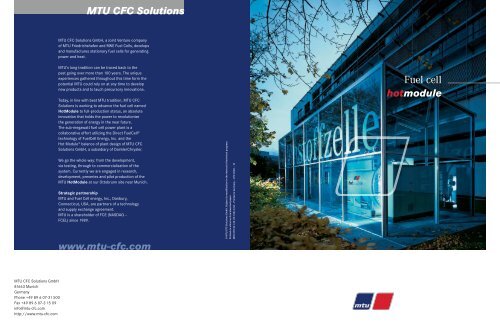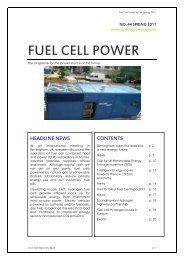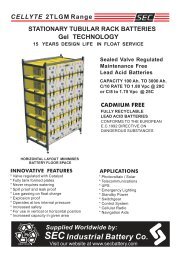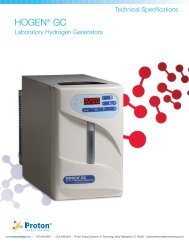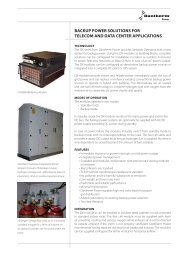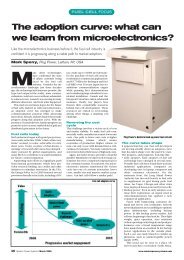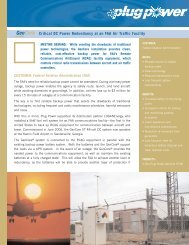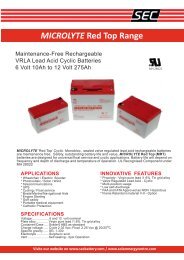MTU CFC Solutions www.mtu-cfc.com Fuel cell ... - Fuel Cell Markets
MTU CFC Solutions www.mtu-cfc.com Fuel cell ... - Fuel Cell Markets
MTU CFC Solutions www.mtu-cfc.com Fuel cell ... - Fuel Cell Markets
Create successful ePaper yourself
Turn your PDF publications into a flip-book with our unique Google optimized e-Paper software.
<strong>MTU</strong> <strong>CFC</strong> <strong>Solutions</strong> GmbH<br />
81663 Munich<br />
Germany<br />
Phone +49 89 6 07-31 500<br />
Fax +49 89 6 07-3 15 09<br />
info@<strong>mtu</strong>-<strong>cfc</strong>.<strong>com</strong><br />
http://<strong>www</strong>.<strong>mtu</strong>-<strong>cfc</strong>.<strong>com</strong><br />
<strong>MTU</strong> <strong>CFC</strong> <strong>Solutions</strong><br />
<strong>MTU</strong> <strong>CFC</strong> <strong>Solutions</strong> GmbH, a Joint Venture <strong>com</strong>pany<br />
of <strong>MTU</strong> Friedrichshafen and RWE <strong>Fuel</strong> <strong>Cell</strong>s, develops<br />
and manufactures stationary fuel <strong>cell</strong>s for generating<br />
power and heat.<br />
<strong>MTU</strong>’s long tradition can be traced back to the<br />
past going over more than 100 years. The unique<br />
experiences gathered throughout this time form the<br />
potential <strong>MTU</strong> could rely on at any time to develop<br />
new products and to lauch precursory innovations.<br />
Today, in line with best <strong>MTU</strong> tradition, <strong>MTU</strong> <strong>CFC</strong><br />
<strong>Solutions</strong> is working to advance the fuel <strong>cell</strong> named<br />
HotModule to full-production status, an absolute<br />
innovation that holds the power to revolutionize<br />
the generation of energy in the near future.<br />
The sub-megawatt fuel <strong>cell</strong> power plant is a<br />
collaborative effort utilizing the Direct <strong>Fuel</strong><strong>Cell</strong> ®<br />
technology of <strong>Fuel</strong><strong>Cell</strong> Energy, Inc. and the<br />
Hot Module ® balance of plant design of <strong>MTU</strong> <strong>CFC</strong><br />
<strong>Solutions</strong> GmbH, a subsidiary of DaimlerChrysler.<br />
We go the whole way: from the development,<br />
via testing, through to <strong>com</strong>mercialisation of the<br />
system. Currently we are engaged in research,<br />
development, preseries and pilot production of the<br />
<strong>MTU</strong> HotModule at our Ottobrunn site near Munich.<br />
Strategic partnership<br />
<strong>MTU</strong> and <strong>Fuel</strong> <strong>Cell</strong> energy, Inc., Danbury,<br />
Connecticut, USA, are partners of a technology<br />
and supply exchange agreement.<br />
<strong>MTU</strong> is a shareholder of FCE (NASDAQ –<br />
FCEL) since 1989.<br />
<strong>www</strong>.<strong>mtu</strong>-<strong>cfc</strong>.<strong>com</strong><br />
© <strong>MTU</strong> <strong>CFC</strong> <strong>Solutions</strong> GmbH. Subject to modification in the interest of technical progress.<br />
Printed on chlorine-free bleached paper.<br />
<strong>MTU</strong> <strong>CFC</strong> 06 133 (70 10E) 2/06 – Printed in Germany – <strong>CFC</strong> 2006 – 10<br />
<strong>Fuel</strong> <strong>cell</strong><br />
hotmodule
ò Modularly<br />
built<br />
ò Environmentally<br />
sound<br />
ò Efficient<br />
ò Suitable for heat<br />
and power<br />
generation and<br />
trigeneration<br />
of power, heat<br />
and cold<br />
ò <strong>Fuel</strong> flexibility<br />
ò Safe operation<br />
ò Compact system<br />
The future of energy supply.<br />
Energy is the driving force in all areas of our modern world.<br />
And our energy requirements are increasing. We are currently faced<br />
with the challenge of ensuring a sustainable energy supply.<br />
<strong>Fuel</strong> <strong>cell</strong> technology is one of the most<br />
promising solutions.<br />
At unrivaledly low emission rates, the<br />
HotModule generates very high electrical<br />
efficiency. The fuel-<strong>cell</strong>-power-plant realizes<br />
a vision of an environmentally friendly<br />
decentralized power supply, run by small<br />
and efficient units.<br />
The solution<br />
Application fields:<br />
Digester Plant Leonberg, Germany Telekom, Munich, Germany Hafen City, Hamburg, Germany<br />
Leading <strong>com</strong>panies from different branches<br />
are working together with <strong>MTU</strong> <strong>CFC</strong> <strong>Solutions</strong><br />
to develop and implement innovative fuel <strong>cell</strong><br />
solutions. <strong>MTU</strong> and its innovative partners<br />
have secured a solid and lasting technological<br />
leadership and <strong>com</strong>petitive advantages, also<br />
setting an example in environmental protection.<br />
Energy utility Beverage industry<br />
Sensitive<br />
production areas<br />
clean<br />
RWE, Essen, Germany<br />
Pharmaceutical and<br />
cosmetics industries<br />
hotmodule<br />
highly efficient<br />
simple<br />
quiet<br />
reliable flexible<br />
low-maintenance<br />
Sewage treatments<br />
and biogas plants Food industry Tele<strong>com</strong>munications<br />
environmentally friendly<br />
Large <strong>com</strong>mercial<br />
enterprises u.v.m.<br />
2 | 3
Technical data<br />
ò 250 kW electric<br />
ò Bis 220 kW<br />
thermal<br />
ò 55% stack<br />
efficiency<br />
ò Operating tempe-<br />
rature of 650°C<br />
ò Operating at<br />
ambient pressure<br />
Characteristics<br />
High efficiency<br />
ò Overall efficiency<br />
of 90%<br />
ò Total electrical<br />
efficiency of 47%<br />
Environmental<br />
friendly<br />
ò No SO2<br />
and no NOx<br />
ò Ca. 30% CO2<br />
reduction<br />
<strong>Fuel</strong> flexibility<br />
ò Natural gas<br />
ò Biogas,<br />
sewage gas, etc.<br />
High value heat<br />
ò Temperature of<br />
more than 400°C<br />
ò Variable electricity<br />
/ steam ratio<br />
Low cost<br />
ò Low maintenance<br />
ò Metallic construc-<br />
tion materials<br />
ò Nickel catalyst,<br />
nickel anode<br />
hotmodule<br />
Brilliantly simple. – Highly efficient.<br />
Exhaust gas + heat output<br />
Simply brilliant.<br />
Brilliantly simple that describes<br />
the principle of generating energy<br />
using fuel <strong>cell</strong>s, cleanliness,<br />
safety and high efficiency from<br />
the entire system.<br />
Efficiency is the outstanding feature of the<br />
HotModule. The fact that we have succeeded<br />
in ac<strong>com</strong>modating all hot parts in a single<br />
housing not only makes parts of the periphery<br />
superfluous but also enables new standards<br />
in efficiency to be set.<br />
Without any flame and without moving masses<br />
such as turbine blades or reciprocating pistons,<br />
it converts the energy contained in the fuel<br />
directly into electricity. The electro-chemical<br />
processes employed enable not only high<br />
efficiencies, but they also keep emissions at<br />
an exemplary low level. The exhaust air is<br />
free of noxious gases as nitrous and sulphur.<br />
Up to 30% more electrical power in <strong>com</strong>parison<br />
with conventional energy generation.<br />
Besides this the exhaust air of the HotModule<br />
consists ofwater vapor, nitrogen and residual<br />
oxygen from the air.<br />
Mixing chamber<br />
and catalytic burner<br />
1. Media Supply<br />
M<strong>CFC</strong> stack<br />
Exhaust gas + heat output<br />
Anode gas<br />
The System<br />
Air oxygen<br />
Manifold<br />
3. Controll unit<br />
and DC/AC inverter<br />
2. M<strong>CFC</strong><br />
HotModule<br />
Power output<br />
Circulating cathode gas<br />
The HotModule consists of three subsystems:<br />
1. A gas cleaning system upstream<br />
of the HotModule: This unit conditions<br />
the fuel gas for the fuel <strong>cell</strong> process.<br />
2. The central steel container:<br />
It contains the fuel <strong>cell</strong> stack; a mixing<br />
chamber for fresh air, anode gas and<br />
cathode air; a collector shroud for the<br />
cathode exhaust; circulating fans and a<br />
heater which is used to start the process.<br />
3. An electrical equipment enclosure:<br />
System controls are contained in it,<br />
and an inverter to convert the direct<br />
current from the fuel <strong>cell</strong> into alternating.<br />
EnBW, Michelin,<br />
Karlsruhe, Germany<br />
4 | 5
Intelligent energy<br />
supply indications<br />
Power<br />
ò Highly efficient<br />
(47% bis 65%)<br />
ò High quality<br />
ò Failure free and<br />
uninterrupted<br />
ò Decentralized<br />
generation<br />
ò Environmentally<br />
friendly<br />
Steam<br />
ò High temperatures<br />
(> 300°C)<br />
ò Process heat<br />
for further power<br />
production<br />
ò Cooling with<br />
absorption<br />
cooling-chillers<br />
ò For sterilization<br />
ò For heating<br />
Hot Air<br />
ò High temperature<br />
level<br />
ò Free of polutants<br />
ò For Heating<br />
ò For sterilization<br />
ò For drying<br />
hotmodule<br />
With the power<br />
out of the fuel <strong>cell</strong>.<br />
The Result: Up to 30% more electrical power in <strong>com</strong>parison<br />
with conventional energy generation and valuable useful heat<br />
and all this with almost no harmful emissions.<br />
The »jump« ó in the efficiency curve<br />
represents an optionally installed<br />
downstream steam turbine.<br />
The thermal energy is used to further<br />
increase the electrical efficiency.<br />
Conventional<br />
energy sources<br />
ò Natural gas<br />
ò Coal gas<br />
ò Residual gas<br />
ò Methanol<br />
Electric efficiency in %<br />
70 Anode Electrolyte Cathode<br />
60<br />
50<br />
40<br />
30<br />
20<br />
10<br />
<strong>Fuel</strong> <strong>cell</strong><br />
PAFC<br />
Diesel and gas engines<br />
0,1 1<br />
10 100<br />
1000<br />
Plant power in megawatts<br />
ó M<strong>CFC</strong>, SOFC without<br />
and with steam turbine<br />
ó Gas and steam power plant<br />
ó Steampower plant<br />
The HotModule can be used for almost any<br />
application. The system automatically generates<br />
the required hydrogen from a number of energy<br />
sources and can therefore be integrated into<br />
practically any existing infrastructure.<br />
Even gas from renewable sources is ideally<br />
suited for generating energy using the<br />
carbonate fuel <strong>cell</strong>.<br />
Usable energy sources<br />
+ Steam turbine<br />
Gas and steam power plant<br />
Steampower plant<br />
Industrial gas turbine<br />
ó PAFC, Phosphoric<br />
acid fuel <strong>cell</strong><br />
ó Diesel and gas engines<br />
ó Industrial gas turbine<br />
Renewable<br />
energy sources<br />
ò Biogas<br />
ò Sewage gas<br />
ò Landfill gas<br />
ò Mine gas<br />
Electron surplus<br />
Gas-supply<br />
If a hydrocarbon energy source such as<br />
methane |CH4| and water |H2O| is added<br />
to the carbonate fuel <strong>cell</strong>, hydrogen |H2| is<br />
released. This hydrogen |H2| reacts with<br />
the carbonate ions |CO3 - - | in the electrolyte<br />
to form water |H2O| and carbon dioxide |CO2|.<br />
˘ This releases electrons | - -|.<br />
A look at how the carbonate fuel <strong>cell</strong><br />
functions makes the simple<br />
electrochemical principle clear:<br />
The <strong>cell</strong> is structured like a sandwich.<br />
It generates power and heat when the anode<br />
is supplied with hydrogen |H2| and the cathode<br />
with oxygen |O2|. In between these two is a<br />
lithium and potassium carbonate electrolyte.<br />
<strong>Cell</strong><br />
temperature<br />
650 °C<br />
Direct current<br />
The carbon dioxide |CO2| and the atmospheric<br />
oxygen |O2| are supplied to the cathode.<br />
Electrons | - -| are consumed, with new<br />
carbonate ions |CO3 - - | constantly being<br />
formed on the cathode.<br />
˘ This releases heat.<br />
Air oxygen<br />
Exhaust air + heat<br />
The new carbonate ions |CO3 - - | in turn<br />
replenish the electrolyte. The carbonate ions<br />
migrate through the electrolyte to the anode,<br />
thus <strong>com</strong>pleting the electrical circuit.<br />
The principle<br />
The individual <strong>cell</strong>s are identical<br />
and can be easily <strong>com</strong>bined<br />
into an assembly.<br />
Electron deficiency<br />
6 | 7


